When it comes to key performance indicators (KPIs), there are the obvious ones and then there are the ones that are more obscure. You want to be tracking the right metrics, otherwise you might be making decisions based on misleading information. Here are ten inbound marketing KPIs you need to be focusing on in 2020.
- Social media: message click-through rate
- SEO: the number of rich snippets
- CTAs: the click-through rate
- Landing pages: the conversion rate
- E-shot emails: percentage of unsubscription
- Automated emails: how they can nurture goal success
- Lead qualification: agreeing on a metric with sales team
- Bounce rate: how long are people spending on your site?
- Customer acquisition cost (CAC) vs. customer acquisition rate
- Return-on-investment: the all-important KPI
1. Social media: message click-through rate
When it comes to social media, many businesses are more concerned with vanity metrics such as the number of likes and shares. But it's not about the amount of engagement your post gets. People might be interacting with your post but how many of them are actually clicking through to your website and reading your content?
You want to get people to come to your website. The best way is to share interesting content that makes them want to click your links.
Measure this by monitoring traffic to your website and filtering it to see what proportion came from your social media channels. The average click-through rate varies from social media platform to platform. Last year, a social media engagement analysis found the following guideline-CTRs:
- Instagram - an average of 1.66% across all industries with non-profit and higher education performing significantly higher than the rest.
- Facebook - an average of 0.17% for all posts across all industries and 0.9% for Facebook ads.
- Twitter - an average of 0.05% across all industries. But Twitter is mainly used as a broadcasting channel rather than for engagement.
Frequency of posts seemed to have an impact on engagement, but it varied across industries and social media platforms due to their different algorithms. The general rule still applied: post often but not too often because you might be viewed as spam. Try and find a balance.
When you're creating your posts, consider:
- Does your social media post relate to the content you've linked it to?
- Are you using a variety of media in your posts aside from images (e.g. a video in one, a poll in another etc)?
- Is the message on the social media post too distracting or uninteresting?
- Are you using the appropriate tone of voice?
2. SEO: the number of rich snippets
When a customer enters a query into a search engine, they’re presented with a list of results. You want to be at the top of that list, right? Actually, you need to be in the answer box or the rich snippet because that's the link the customer is most likely to notice and click on.
But how can you do that? If you Google "How much does AdWords cost in the UK", you'll see that a post we've written will come up in the rich snippet box. We did this by prioritising giving the answer and using a few simple technical SEO tricks. The main focus was to put UX as the most important thing.
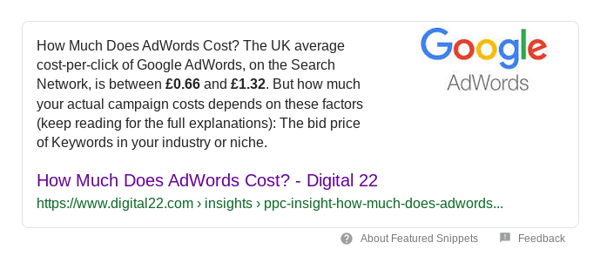
Example of a search query appearing in the rich snippet box
By answering the question in the first sentence, we made sure that the reader got what they searched for instantly. If they didn't click on the link after seeing the answer box, then they probably weren't someone we needed to target anyway.
If they did click through, they'd get their answer plus a list of factors that contribute to the cost of AdWords. It's additional information that our target audience would probably want to know, which would entice them to scroll down, read on and even click on the CTA.
Measuring this is very simple - all you need to do is track the number of rich snippets your targeted keywords hold and monitor how many click-throughs you've gotten to your site. You'll notice when a blog or page has earned a rich snippet because views will jump massively.
3. CTAs: the click-through rate
It's important to have an epic and eye-catching Call-To-Action because it'll entice your customers to click on it. Why does this matter? Because you want your customers to download your content. It's a chance for you to gain their contact details so you can nurture them through the funnel via emails.
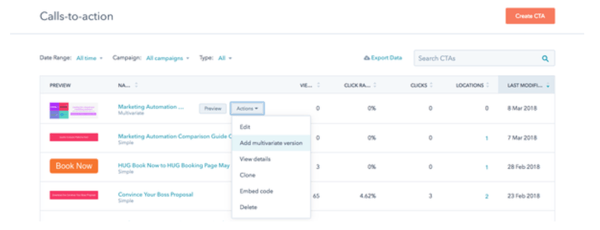 Example A/B test being ran on a CTA
Example A/B test being ran on a CTA
HubSpot allows you to measure and analyse the click-through rates of your CTAs. Create an A/B test and run them on a regular basis (check out this guide too). If you find that you're getting a low click-through rate, consider the following:
- Is it the format of your CTA? Would a simple button, different colours or an image work better?
- Are you using action words such as "Improve Your Results Here"?
- Does the text in the CTA reflect what your lead will be downloading?
4. Landing pages: the conversion rate
So your landing page is up and running. It's well-written, visually appealing and follows all of the best practices. But all of that's no good if it's not actually converting any of your customers.
Monitor your conversion rate by continuously A/B testing this area. Try changing just one thing at a time, such as the colour of your button or making the written content more persuasive, and see what happens.
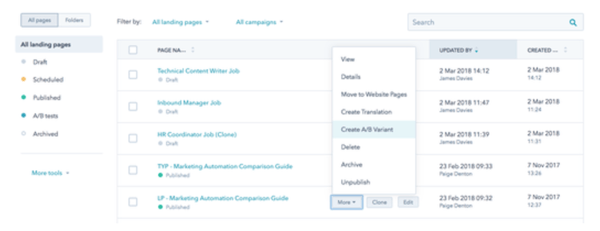 Example A/B test being ran on a landing page
Example A/B test being ran on a landing page
5. E-Shot emails: are people engaging?
Many people see e-shot emails as annoying or too 'salesy', but email marketing is actually a powerful tool that can encourage your audience to engage with your content and help you nurture them along their Buyer's Journey.
That's why you need to fashion your e-shot emails in ways that make your customers want to click and read them. A relevant, eye-catching email headline, appropriate images and compelling content are all great ways to do this.
You can measure whether or not your e-shot emails are working by monitoring various metrics including open rate, click-through rate and conversion rate.
When it comes to how many email campaigns you should be sending, there’s no right or wrong answer. The marketing experts at HubSpot recommend between 16 and 30 campaigns a month (though we advise segmented recipients as much as possible). Companies that follow this see an average open rate of 32.4% and median click rate of 6.5%.
However, you should adjust the number of emails you send depending on the size of your company. To improve open rates, continuously conduct A/B tests in order to enhance this performance.
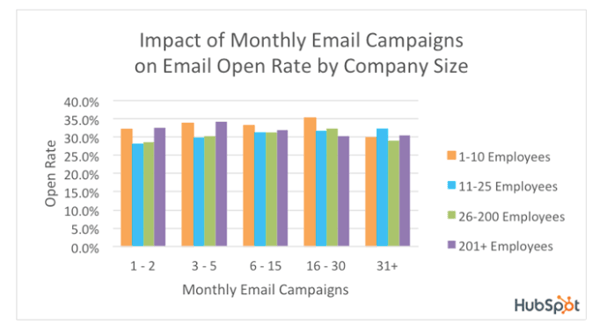 Correlation between the number of email campaigns sent, open rate and company size. Image credit
Correlation between the number of email campaigns sent, open rate and company size. Image credit
6. Automated emails: monitor engagement
Automated email workflows are something you should already be using because they ensure that your contacts are encouraged down their Buyer's Journey as opposed to sitting dormant in your marketing database.
Similar to your sales metric, find your benchmark for automated email engagement. Monitor this over time to see what's working and what's not and use that data to improve future automated emails.
Some questions you should be asking when monitoring engagement are:
- Is the email catered to the right stage of the Buyer's Journey?
- Is it the right frequency? Are you sending too many/too few emails?
- Do you have a strong, compelling headline?
- Will the contact find the content interesting and relevant?
- Is the content well-written?
- Have you taken a subtle approach to getting your contacts to download your content or is it too sales-y?
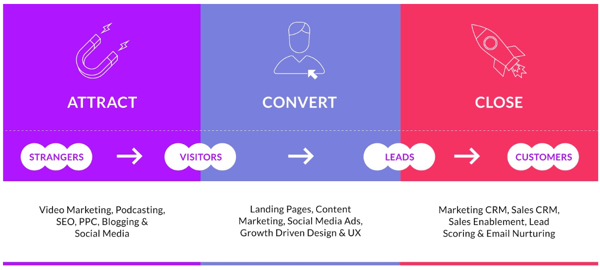 Make sure your workflows actually do move contacts through this journey.
Make sure your workflows actually do move contacts through this journey.
7. Lead qualification: agreeing on a metric with sales team
Once you and your marketing team have collated data about your prospects and leads, it's time to turn that over to the sales staff so they can close the deal and convert these potential customers into actual customers.
Ensure that your marketing team and the sales team have agreed on a way you can accurately measure how well you're doing at handing over qualified leads. Agree on how many you need to deliver a month.
Some example performance metrics include:
- Lead has opened four consecutive emails (sales should put them on their radar)
- Lead has downloaded more than two consideration stage content pieces (consider reaching out via email)
- Lead has downloaded at least one decision stage content piece (at least send an email)
- Lead has downloaded our price guide (give them a ring)
Without having a metric that you can measure and monitor, there's little way you'll be able to get accurate data on how well you're doing. If you don't know that, it'll be difficult for your team to perfect your marketing tactics.
8. Bounce rate: how long are people spending on your site?
Bounce rate is a crucial KPI. It’s a track of the percentage of people who make it to your site and then ‘bounce’ right off it. Tracking bounce rate is useful in terms of web design as they help you understand if your landing pages are working successfully.
What you want is a low bounce rate. This means visitors are resonating with the content you’re supplying on a particular page. If they’re not, your bounce rate will be high and you’ll probably need to change up a few things. It could be layout issues, like text-heavy pages or confusing navigation that is putting people off.
In terms of content - are you answering the question easily? Do you have a strong enough hook? Are the headings interesting?
9. Customer acquisition cost (CAC) vs. customer acquisition rate
How much does it actually cost you to acquire a new customer?
It’s usually more expensive to gain a new customer than retain an old one, but a CAC can give you some important information. It can tell if you if your overall marketing strategy is successful. If you’ve got a really high CAC and you’re only acquiring a couple of customers, you’ll want to rethink this strategy. How can you have a good CAC to customer acquisition ratio? For example, if your outbound strategies aren’t looking to be effective, why not try inbound marketing?
10. Return-on-investment: the all-important KPI
This is the big-one. It’s one of the most important metrics to track and will convince anyone that your marketing efforts are working.
Luckily, when it comes to inbound marketing, ROI is a lot easier to track than with outbound techniques. Because of the digital nature of inbound, you can track who’s coming to your site, who’s clicking on what and if they’re making a purchase. Plus, if we mix in a great CRM like HubSpot with the inbound methodology, we can figure out exactly what journey the buyer made to making a purchase.
What do you think is more relevant in marketing today, a Yellow Pages ad or a relevant online blog? An ROI will be able to prove the efficiency of both.
No-one wants to support a marketing tactic that's losing the company money, so ensure that you're tracking the right KPIs in order to make adjustments to your strategies and budgets.
Sales revenue, leads and cost per acquisition are the most obvious KPIs to follow, but there are a number of other metrics that can help you execute a more successful campaign and improve your overall inbound marketing efforts.
Want to explore a 12 month inbound marketing strategy?
Knowing which marketing KPIs to track goes a long way towards creating the ideal inbound marketing strategy, but there's still much more you need to know. If you’re interested in seeing what a strategy looks like over 12 months, look no further.
We’ve created a helpful slidedeck to help you see what strategies and methods and inbound agency uses. It will also answer all of your burning questions about what an inbound marketing strategy is like.
Click the link below to download.
This blog was originally posted in 2018 by Mayzin Han. It was updated for the start of 2020 by Jack Cribb.
Real Growth. Real Impact.
'Should I use HubSpot?' 32 fundamental reasons why you should
21 cost-effective marketing campaigns you can create right now
Breeze: Everything you need to know about HubSpot's powerful AI
INBOUND 24 learnings and updates
Google Search API leaks: All you need to know [LIVE BLOG]
The top 6 marketing challenges of 2024
Inbound vs outbound marketing: What's the difference?
See why enterprises choose Avidly
Let’s build your HubSpot success story
Compelling final call to action - with accompanying link to Contact page





![Google Search API leaks: All you need to know [LIVE BLOG]](https://www.avidlyagency.com/hs-fs/hubfs/cloud.jpg?width=400&height=225&name=cloud.jpg)


